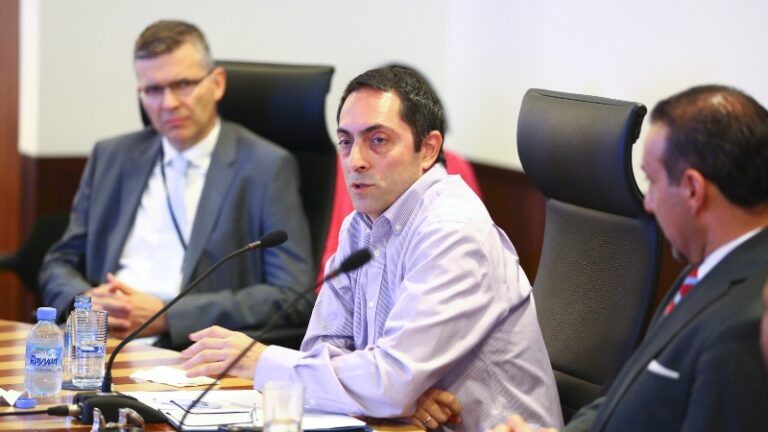Dialogue Series, Distingushed Lectures, Regional Studies
Luciano Zaccara on the Iranian Elections

Luciano Zaccara, Visiting Assistant Professor at Georgetown University SFS-Qatar, delivered a CIRS Focused Discussion on the topic, “Do Elections Matter? Reflections on the 2013 Iranian Presidential Polls” on September 30, 2013. Answering this question in the affirmative at the start of the lecture, he went on to explain why elections are so important to the Iranian political system. Having conducted extensive fieldwork in Iran, Zaccara observed in-situ the last six electoral processes in Iran, including the Presidential Elections of 2005, 2009 and 2013; the Legislatives Elections of 2008 and 2012; and the Municipals and Assembly of Experts elections of 2006. He explained that “electoral life in Iran is very active; in the last 34 years of the Republic’s history there were 32 electoral processes in Iran,” which reveals how significant elections are for the regime to legitimize its political processes and institutions.
Giving some historical background, Zaccara noted that there have been a total of eleven presidential elections since the creation of the Islamic Republic. He added that only two presidents did not complete their terms; one was President Bani-Sadr who was impeached in 1980, and the other was President Rajai who was assassinated in 1981. The third, fourth, fifth, and sixth presidents, Khamenei, Rafsanjani, Khatami, and Ahmadinejad, were elected for two terms, which is the maximum allowable time in office. Of these, Rafsanjani and Khamenei obtained the highest proportion of votes with 95 percent each. Although Ahmadinejad officially attracted more participation in the electoral process, with figures reaching up to 83 percent, he was the most contested candidate in the history of Iranian elections.
Elections in Iran are vital for the survival of the political system despite the various governmental constraints. He explained that “electoral processes have very important functions in Iran, even within the authoritarian limits set by the constitutional and electoral frameworks, which are very particular in the Iranian case.” Despite the uproar regarding the 2009 results, electoral processes in Iran have important functions. “First, they draw much light over the intra-elite dispute. Second, they serve the government to check periodically on the people’s orientation. Third, but no less important, they bring candidates into office, sometimes with unexpected results. And fourth, they determine the government’s composition,” Zaccara argued.
Describing the electoral process itself, Zaccara said that the voting system implemented in Iran in unique: there is no official registration of number of voters; the percentage of voters is calculated on a population census; and citizens can cast their vote in any polling station in the country. All these factors make it difficult for researchers and officials who study voting patterns to determine the exact proportion and geographic location of voters. Because of these unusual factors, many international observers believed that the results of the 2009 elections were fabricated. However, he said, keeping in mind the way in which the electoral framework is implemented in Iran, the history of result publication proves that these kinds of numbers are indeed possible. Zaccara added that a further difficulty for researchers is to compare election results over the years as the official information provided is not always consistent.
During the 2013 elections, 675 candidates were officially registered, but only eight made it through the strict criteria to enter the final stages of the elections. Of these, Rohani won the most votes and inaugurated his term as president on August 3, 2013. The week before the elections, Rohani had less than 10 percent of voting intention. However, the day after a key debate where he emphasized the importance of foreign policy, his popularity increased sharply indicating public interest in moving away from the isolationist policies of his predecessor. As a further indicator of the public’s desire for a new type of leadership, he received only 39 percent of votes obtained in Qom, which is considered the center of Shi’a religious clergy, while in peripheral provinces such as Sistan-Baluchistan Rohani obtained more than 73 percent of the vote. In Tehran, the most important and populated district he obtained 48 percent.
In conclusion, Zaccara argued that, on the domestic side, the most recent elections in Iran provided a re-legitimation of the political system and a recuperation of the population’s trust after the events of 2009. “My hypothesis around the results is that the popular support towards a particular candidate is not ideological, but highly circumstantial,” he said. On the international front, the elections have helped in the slow recovery of trust and opening up dialogue between Iran and the rest of the world.
Luciano Zaccara is the director of the OPEMAM-Observatory on Politics and Elections in the Muslim and Arab World, and an Honorary Research Fellow at the Institute of Arab and Islamic Studies, University of Exeter. His previous positions include a postdoctoral fellowship at Institute of International Studies, Autónoma University of Barcelona, and several research fellowships at the Department of Arab and Islamic Studies, Autónoma University of Madrid. He holds a Ph.D. in Arab and Islamic Studies from Autónoma University of Madrid and a BA in Political Science from the National University of Rosario in Argentina. His publications include the monograph El Enigma de Irán (2006), and the co-edited book Elecciones sin Elección. Procesos Electorales en Medio Oriente y Magreb (2009), as well as many articles on Middle East domestic and international politics, and mainly on Iranian politics and elections.
Article by Suzi Mirgani, Manager and Editor for CIRS Publications.